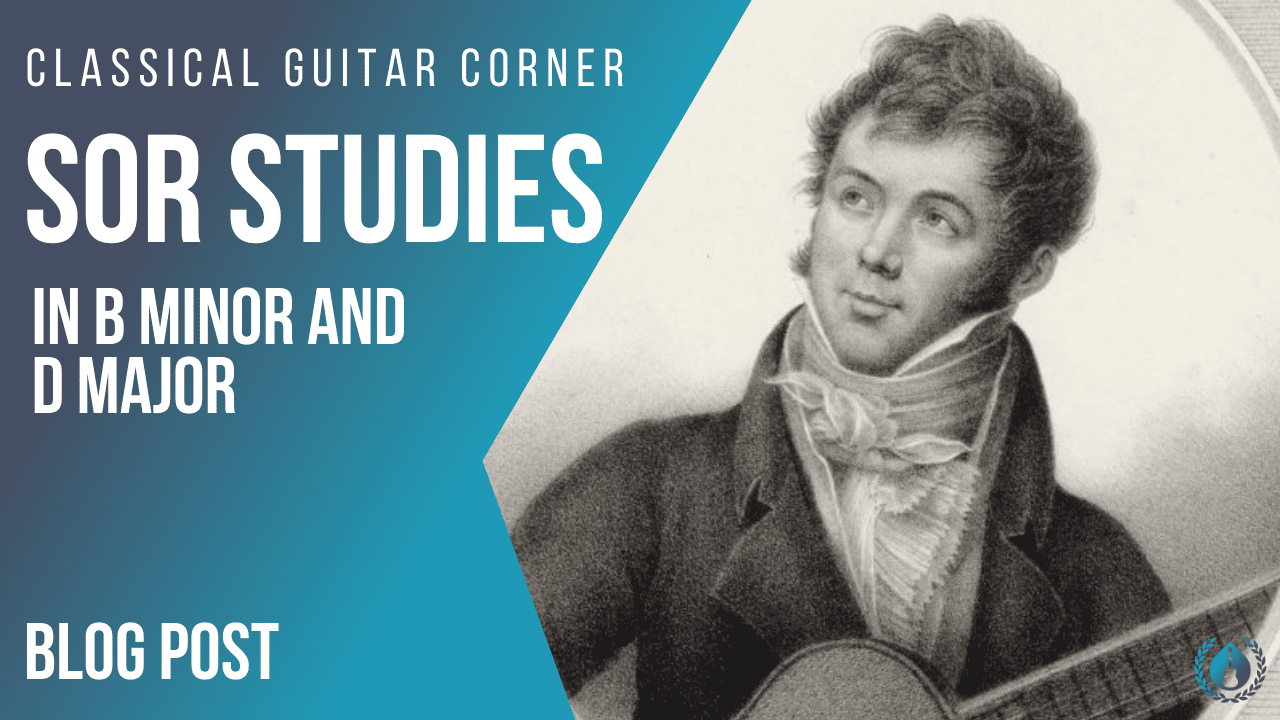The Studies of Fernando Sor are perhaps some of the most beloved pieces of music on classical guitar. I think a lot of that has to do with the curation of Maestro Andrés Segovia and his popular edition of the “Segovia 20 Sor Studies.” That edition introduced the music of Sor to an entire generation of guitarists and to this day many guitarists still know each study by the Segovia numbering.
Segovia No.5 & Segovia No.6
For instance, two of the most well-known pieces of that collection are the Study in B minor (Segovia No.5) and the Study in D Major (Segovia No.6).
Both of these studies come from Sor’s Op. 35, which bears the title (in French in the original) 24 Exercices très faciles, or 24 Very Easy Exercises.
What many guitarists have learned, however, is that these are in fact not easy pieces at all.
They are challenging in so many ways, but primarily in the musical demands they place on the performer.

Musicality
Sure, there are some technical elements to take care of in each, but what is much more challenging is constructing convincing musical phrases, bringing out the separate voices, and allowing the music to have dynamism and depth.

Especially with these studies, the difference between a performance that is technically correct without mistakes, and a performance that allows the music to truly come alive is stark.
Study in B minor (Op. 35, No.22)
Sor’s Study in B minor from Op. 35 at first glance looks like a simple arpeggio study. And it is indeed a study that develops right-hand arpeggios. However, it is equally a study about voices, and differentiating melody from accompaniment in the right hand. That requires control and balance in the right hand, technically, but it also requires a musical understanding of balance of voices and harmony to know best which voice to bring out at different moments. We’ve included a performance video below of what’s possible with this beautiful piece of music. Moving from technically correct to musical mastery is not only not easy but invites many years of exploration, discovery, and expression. Check out a podcast dedicated to making Sor’s Bm Study really sing here.
Performance:
Study in D Major (Op. 35, No.17)
Sor’s Study in D Major from Op. 35 is also an arpeggio study on the surface. But here the accompaniment incorporates rests that, when honored, create a completely different rhythmic feel than simple arpeggios might. So in truth the study is really about a dialogue between two voices. Whereas you might hold fingers down in the left hand to create a beautiful wash of sound (similar to using the sustain pedal on the piano), here we can lift the left-hand fingers to accentuate this dialogue and to create more interesting lines in each voice. Likewise, we can use right-hand bass stopping to prevent bass notes from ringing beyond their durations. Essentially these more challenging technical approaches produce a more musical and singing result.
Performance:
***
Both of these studies, along with many other Sor studies and other wonderful pieces from the classical guitar repertoire, are included in our Graded Repertoire for Classical Guitar book.
Pick up your own copy at CGC Publishing.
For more lessons and performances of pieces from our Graded Repertoire book, visit our Free Lessons page here.



I studied these pieces at Vincent d’Indy Motreal in 1972 and still playing them with the same pleasure…
love these Sor studies; timeless!
I have played both of these studies for years and thoroughly enjoy them still. My favorites, however are #9 (Opus 31 No.20) and #19 (Opus 29 No.13). I like 9 because it’s fun to play and 19 for its sheer beauty, in spite of its difficulty.
Thank you for the discussion of the study. Good to review how playing the harmony at a relatively lower dynamic will make the melody stand out in contrast so it can sing.
Hi Cadie, they’re quite wonderful and there is always something new to discover in them!
Peace,
Dave B (CGC team)
I completely agree, Robert! As I mentioned to another commenter, there is always something new to discover in these wonderful studies.
Peace,
Dave B (CGC team)
Hi Peg,
Those are both great! Segovia was especially fond of #19 and recorded it multiple times.
Peace,
Dave B (CGC team)
You’re most welcome, Claudia! Best of luck as you put those musical touches on these beautiful pieces!
Peace,
Dave B (CGC team)
Thank You for the podcast. Good to review how playing harmony notes at a relatively softer dynamic will make the melody stand out and sing. Sors study in B minor has a beautifully composed melodic pattern.
[…] Powis, Simon. “Sor Studies in B Minor & D Major.” Classical Guitar Corner, 2022. Link: https://www.classicalguitarcorner.com/sor-studies-in-b-minor-d-major/. […]
Thank you. Both of these studies are among my favorites from the Segovia book. I have enjoyed playing these over the years and appreciate a fresh perspective.
Is there a known resource that correctly grades all Segovia/Sor studies? I found conflicting information using the usual methods, so any help you can provide would be much appreciated.
Hi Tony,
Thanks for your question. No, there is not a graded selection of each one of the Segovia/Sor Studies. However, many of those same studies have been included in graded repertoire books and we have also included Sor’s Studies in our Grades curriculum at CGC. So, for instance, Segovia/Sor Study 1 (Op. 6, No.8 in C Major) is a Grade 7 piece in our curriculum. I reference a couple of the other grading choices for specific pieces in the first section of the article above as well. Best wishes!
Peace,
Dave B (CGC team)
Hello you play Sor very good